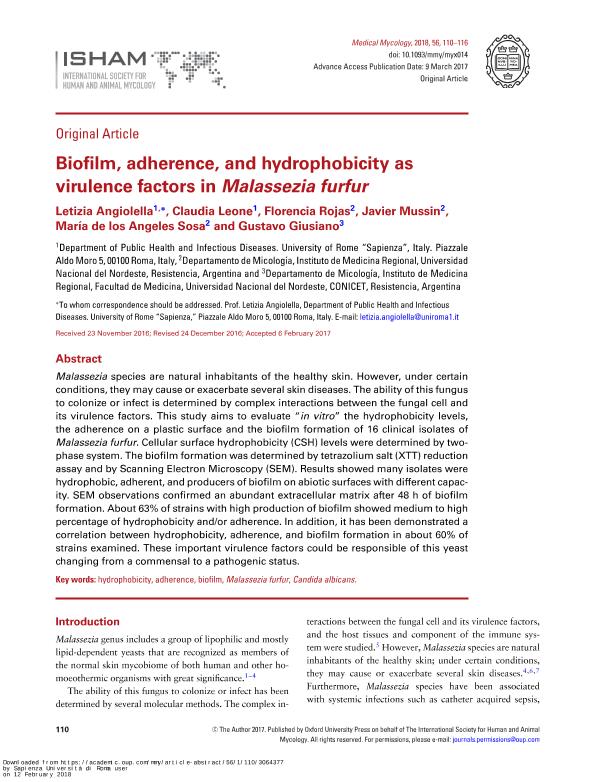Artículo
Biofilm, adherence, and hydrophobicity as virulence factors in Malassezia furfur
Angiolella, Letizia; Leone, Claudia; Rojas, Florencia Dinorah ; Mussin, Javier Esteban
; Mussin, Javier Esteban ; Sosa, Maria de Los Angeles; Giusiano, Gustavo Emilio
; Sosa, Maria de Los Angeles; Giusiano, Gustavo Emilio
 ; Mussin, Javier Esteban
; Mussin, Javier Esteban ; Sosa, Maria de Los Angeles; Giusiano, Gustavo Emilio
; Sosa, Maria de Los Angeles; Giusiano, Gustavo Emilio
Fecha de publicación:
01/2018
Editorial:
Taylor & Francis Ltd
Revista:
Medical Mycology
ISSN:
1369-3786
e-ISSN:
1460-2709
Idioma:
Inglés
Tipo de recurso:
Artículo publicado
Clasificación temática:
Resumen
Malassezia species are natural inhabitants of the healthy skin. However, under certain conditions, they may cause or exacerbate several skin diseases. The ability of this fungus to colonize or infect is determined by complex interactions between the fungal cell and its virulence factors. This study aims to evaluate “in vitro” the hydrophobicity levels, the adherence on a plastic surface and the biofilm formation of 16 clinical isolates of Malassezia furfur. Cellular surface hydrophobicity (CSH) levels were determined by two-phase system. The biofilm formation was determined by tetrazolium salt (XTT) reduction assay and by Scanning Electron Microscopy (SEM). Results showed many isolates were hydrophobic, adherent, and producers of biofilm on abiotic surfaces with different capacity. SEM observations confirmed an abundant extracellular matrix after 48 h of biofilm formation. About 63% of strains with high production of biofilm showed medium to high percentage of hydrophobicity and/or adherence. In addition, it has been demonstrated a correlation between hydrophobicity, adherence, and biofilm formation in about 60% of strains examined. These important virulence factors could be responsible of this yeast changing from a commensal to a pathogenic status.
Palabras clave:
Malassezia
,
Hydrophobicity
,
Scanning Electron Microscopy
,
Adherence
Archivos asociados
Licencia
Identificadores
Colecciones
Articulos(CCT - NORDESTE)
Articulos de CTRO.CIENTIFICO TECNOL.CONICET - NORDESTE
Articulos de CTRO.CIENTIFICO TECNOL.CONICET - NORDESTE
Citación
Angiolella, Letizia; Leone, Claudia; Rojas, Florencia Dinorah; Mussin, Javier Esteban; Sosa, Maria de Los Angeles; et al.; Biofilm, adherence, and hydrophobicity as virulence factors in Malassezia furfur; Taylor & Francis Ltd; Medical Mycology; 56; 1; 1-2018; 110-116
Compartir
Altmétricas



